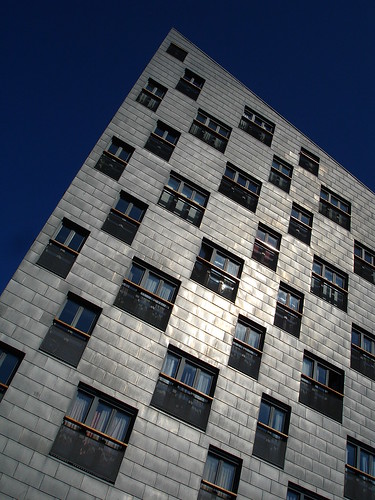
You really have to hand it to the architects that designed Borneo Island in Amsterdam.
The variety and novelty of buildings on show is superb. Even if you have no education in architecture, or even a passing interest in it, it is hard not to be impressed by the buildings on show.
Some of the houses were delivered as a shell that could then be designed and personalised by the owners which has resulted in some intriguing layouts and interior spaces. The external facades nevertheless retain a coherency despite this individualistic approach.
My particular favourite is a huge silver construction that is known as “The Whale”.
I normally have an aversion to vast buildings. The sheer bulk and weight of such structures can be too overpowering at times and can dwarf the surrounding buildings to a suffocating extent.
The Whale however is different.
I’ve often wondered why it is I have such a different feeling for this building. At first I thought that it was the sheer imaginativeness of the shape. It really does look like a huge whale tail dipping into the water. A shimmering, silver mirage of a thing.
However there is another reason for my appreciation, which I have only now come to understand.
The Whale allows a lot of light to pass through it and it casts less of a shadow than you would expect from such a huge structure.
As it turns out, this is no accident. That whale tail shape wasn’t chosen as some novelty design. Rather, it was an accidental form that emerged from an engineering problem – how to allow light into the interior gardens of such a large building.
The answer was ingenious. I’ll leave it to the architects, Cie, to explain:
By elevating the building on two sides – the line of the roof corresponding to the
movement of the sun – the lower floors receive sunlight coming in from under the actual
building.
Accordingly, light and space have free access into the heart of the building. The result
is a redefinition of the closed block: the inner area transforms the traditionally private domain
into an almost public city garden. The elegant, elevated form conceals the enormous program:
214 apartments with business areas underneath and an underground car park on a plot as
large as a football field.
As a consequence of its extraordinary design, The Whale consistently
affords different views of the environment from various positions generating at the same time
an enormous diversity of housing types, in the lower and upper edges of the building in
particular. Conservatories provide a wide view of Amsterdam’s inner city and across the
expansive waters of the river IJ.
In the interior, The Whale exudes an atmosphere of intimacy through the wooden finishing and
the inner garden. The diagonal lines are reproduced in the interior of the building in a staggered
pattern of galleries. These offer access both to the houses on the shared level and to those on
the floor above, so that an additional variation in lower/upper apartments can be obtained.
Each of the elevated corners is supported by a glass stairway with a lift. On the outside, the
taut lines are continued in the aluminium roof and the zinc frontage material. The Whale’s
sculptural character gives the building a stylish metropolitan presence.
More here